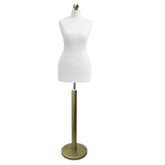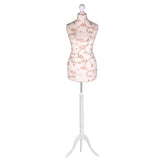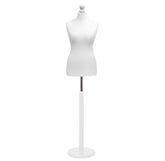How to Sew Invisible Zippers: Easy Tips for a Perfect Finish
Getting an invisible zipper right comes down to a few key things: using a special invisible zipper foot, stitching one side of the zipper tape to your fabric, aligning the second side perfectly, and then sewing it down. The real magic happens when you stitch very close to the zipper coils, which allows them to flip over and completely hide the seam once the zipper is closed.
Your Essential Invisible Zipper Toolkit
Before you even think about starting, let’s talk tools. Getting your setup right from the beginning is the secret to a professional finish and a stress-free experience. Think of it as your pre-flight check; a few minutes of prep here will save you a world of frustration later. While you can get by with the basics, a few extra items can truly elevate your work.
The Non-Negotiable Tool
If there's one thing you absolutely cannot skip, it's the invisible zipper foot (sometimes called a concealed zipper foot). This isn't just a recommendation; it's a necessity.
This special foot has unique grooves on the underside that are perfectly shaped to guide the zipper coils right under your needle. This lets you stitch incredibly close to the teeth—a level of precision you just can't get with a standard foot. In the UK, both home sewists and professional garment factories rely on modern machines for this kind of accuracy. In fact, electric and computerised models now account for 46.19% of the UK's sewing machine market revenue in 2024. You can find more insights into the UK's textile manufacturing scene over at statista.com.
Supporting Cast for Success
Once you have your special foot, a few other trusty tools will make the whole process go much more smoothly.
- Fine-Point Pins: When working with delicate fabrics like silk or chiffon, you'll want sharp, fine-point pins that won't leave permanent holes or cause snags.
- Fabric Marker or Chalk: A good quality disappearing ink pen or a sharp piece of tailor's chalk is your best friend for marking the zipper placement with absolute precision.
- Sharp Scissors: A dedicated pair of fabric shears for clean cuts is a must. For the small, fiddly jobs like trimming threads, having the right kind of scissors in sewing makes a huge difference.
Pro Tip: I always recommend buying a zipper that's at least a few centimetres longer than the opening you're sewing it into. This little bit of extra length gives you room to manoeuvre around the bulky zipper pull at the top, and you can simply snip off the excess at the end.
Essential vs Recommended Tools for Invisible Zippers
To make it even clearer, I've broken down what you absolutely need versus what's nice to have. The essentials will get the job done, but the recommended items are what take your finish from "homemade" to "hand-crafted."
| Tool | Category | Why It's Important |
|---|---|---|
| Invisible Zipper Foot | Essential | Its unique grooves are the only way to get the needle close enough to the coils for a truly invisible finish. |
| Sewing Machine | Essential | Provides the consistent, strong stitch needed. Hand-sewing an invisible zip is not a practical option. |
| Sharp Fabric Shears | Essential | Ensures clean, fray-free cuts on your fabric and zipper tape. |
| Fine-Point Pins | Essential | Securely holds the zipper in place without damaging delicate fabrics. |
| Iron & Ironing Board | Recommended | Pressing the zipper coils flat and setting the seam makes a massive difference to the final professional appearance. |
| Fabric Marker or Chalk | Recommended | Allows for precise marking of the zipper's start and end points, ensuring perfect alignment. |
| Seam Ripper | Recommended | Let's be honest, mistakes happen! A good seam ripper is a lifesaver for undoing stitches without damaging fabric. |
Ultimately, investing in the right tools, especially the invisible zipper foot, is an investment in your final garment. It’s the small details that create a truly polished look.
Prepping Your Fabric and Zipper Like a Pro
A flawless invisible zipper has less to do with the final stitch and more to do with what happens before you even get to the sewing machine. These small, deliberate steps are the real secret behind a zip that genuinely vanishes into a seam, separating the pros from the beginners. Get this part right, and the rest is easy.
First things first: always pre-wash and press your fabric. This isn't just a suggestion; it's essential. It stops the fabric from shrinking around the zipper tape later on, which is what causes that dreaded puckering after the first wash. Ironing your fabric smooth also gives you a perfectly flat, stable surface to work on.
Stabilise Your Seam Allowance
If you're working with anything delicate or stretchy—think jersey, chiffon, or even lightweight cottons—the fabric can easily warp and stretch as you sew. To prevent this, you need to add a bit of stability to the seam allowance where the zipper will live. This is a job for interfacing.
Applying a thin strip of lightweight fusible interfacing along the wrong side of the fabric, right where you'll be sewing the zip, makes a world of difference. It gives the fabric just enough structure to support the zipper and stitches, keeping the whole area crisp and flat. If you're new to this, you can learn more about what interfacing is in sewing to pick the right one for your project.
The Secret to a Closer Stitch
Here’s a little trick that completely changed my zipper game: gently press the zipper coils flat before you even think about sewing.
With the zipper open, use a cool iron to carefully press the coils so they uncurl and lie flat. This simple move opens up the channel right beside the teeth, letting your invisible zipper foot get your needle incredibly close to the coils.
Honestly, this one step is probably the most important for getting a truly invisible finish. It moves the curled teeth out of the way, so when you finally close the zip, the two sides of the fabric meet perfectly over the top, hiding it completely. Just be gentle with the heat—you only need enough to flatten the coils, not melt them. This is the key to mastering how to sew invisible zippers with real precision.
Getting That Invisible Zipper Sewn In
Right, with all the preparation done, it's time to actually sew the zipper into your garment. This is where the magic happens, but it relies on taking things one step at a time. The goal is to make that zip completely disappear into the seam, and precision is everything.
A truly professional finish starts from the very first pin. The sequence of marking, stabilising the seam with interfacing, and then finally stitching the zipper is a process where each step builds on the last. This little infographic gives a great overview of the core stages we're about to tackle.
As you can see, a successful installation begins well before you even sit down at the machine. Getting those measurements and seam reinforcements spot on creates the perfect foundation for a flawless result.
Attaching the First Side
First things first, open your zipper all the way. Lay one side of the zipper tape onto the right side of your fabric, lining it up with one edge of the seam allowance. You want the zipper coils to sit directly on your marked seam line, with the tape itself falling within the seam allowance. Make sure the right side of the zip is facing the right side of the fabric.
Carefully pin this side in place, working from the top down. I find it helps to place the pins horizontally. Just be mindful not to stretch or pull the fabric out of shape as you go.
Once it's secure, it's time to pop over to your sewing machine.
Switch to your invisible zipper foot. You'll notice it has grooves on the underside; place the zipper coils into the correct groove. This is the clever part – the foot will guide the coils perfectly, letting your needle get incredibly close as you sew.
My best advice here is to take it slow and steady. There's no prize for speed. Your aim is a nice, straight line of stitching from the very top of the garment right down to the zipper stop, or at least as far as the foot lets you get. Don't forget to backstitch at the start to lock it in.
Aligning and Sewing the Second Side
This is the make-or-break moment, especially if your garment has features like a waist seam, darts, or colour-blocked panels that absolutely must line up.
Start by closing the zipper you've just sewn. Now, on the unsewn side of your garment, use a fabric marker to make small, horizontal marks on the zipper tape that correspond exactly with your waist seam or any other pattern lines. Think of these as your personal guideposts.
Now, open the zipper back up. Pin the second side of the zipper tape to the other piece of fabric, carefully aligning your new marks with the seams they match. For something really crucial, like a fitted waistband, I often hand-baste this side in place first. It takes an extra minute but guarantees perfection. This is just one of many little sewing techniques that can really take your work to the next level.
With everything pinned (or basted), it's back to the machine. This time, you'll feed the zipper coils through the other groove on your invisible zipper foot. Sew this second side down, again starting from the top and making your way to the bottom.
Once you're finished, do up the zip. Your seams should meet perfectly, and the zipper itself should have vanished into the seam line, leaving only that neat little pull tab visible at the top. This careful alignment is the final, satisfying piece of the puzzle.
Finishing the Seam for a Seamless Look
You're on the home straight now that the zipper is neatly stitched in. This last part is all about creating a flawless transition from the base of the zip to the rest of the seam, making the closure completely disappear into your garment. Getting these little details right is what separates a homemade look from a truly professional finish.
First things first, switch out your invisible zipper foot for a standard zipper foot. Zip up your newly installed zipper and lay the garment flat, focusing on the unsewn part of the seam just below the zipper. We'll be sewing from the bottom of the zip downwards.
Closing the Remaining Seam
With your standard zipper foot back on the machine, you need to position your needle very precisely. The aim is to start this new line of stitching just a fraction to the side of the very last stitch you made on the zipper tape. You're looking for a slight overlap, which is the secret to avoiding any bumps or gaps where the two seams join.
Before you hit the pedal, lower the needle by hand to double-check its placement. Once you're satisfied, sew a couple of backstitches to lock the seam securely, and then continue sewing down the rest of the seam as you normally would. Sticking to your designated seam allowance is crucial here for a perfect fit. If you're unsure, it's always worth a quick refresher on what seam allowance is.
Key Takeaway: The trick to a smooth finish is starting the seam just to the side of the final zipper stitch. This tiny adjustment prevents that tell-tale pucker or dip at the base of the zip.
This technique is a cornerstone of modern dressmaking. Invisible zippers really took off in UK fashion manufacturing in the early 1980s, allowing for the sleek, uninterrupted lines that were so popular in that era's designs. You can find more on the history of the UK's sewing thread market at grandviewresearch.com.
For the final touch, take your garment over to the ironing board. Press the main seam open below the zipper, making sure everything lies perfectly flat. This final press really sets the stitches and completes the illusion, making your zipper truly invisible.
Troubleshooting Common Zipper Problems
Even the most seasoned sewist runs into trouble with invisible zips now and then. Let's be honest, they can be a bit fussy. The most common issue I see is a wavy or puckered seam, which is a dead giveaway that the fabric has stretched while you were sewing. This happens all the time with knits or silky, delicate fabrics.
Another classic problem is when the zipper teeth show on the right side of the garment. If you can see them, it simply means your needle didn't get quite close enough to the coils. Don't panic! Grab a sharp seam ripper and gently unpick the seam. Go slowly – the last thing you want is to damage your fabric.
Resetting for Success
Once the stitches are out, take a breath and reset. The key is to fix the underlying problem before you try again.
- Tackling Wavy Seams: The best way to prevent stretching is to stabilise the seam allowance. I always recommend applying a thin strip of lightweight fusible interfacing along the fabric edge where the zip will sit. It works wonders.
- Hiding Visible Teeth: This one has a simple trick. Use your iron on a cool setting to gently press the zipper coils away from the tape. This unrolls them just enough, making it much easier for your invisible zipper foot to guide the needle right up against them on the next pass.
A little tip from my own sewing room: for particularly shifty fabrics, I always hand-baste the zipper in place after unpicking. It might seem like an extra chore, but it’s far less painful than having to unpick the same seam for a third time because it slipped!
After you've prepped, carefully re-pin the zip, making sure the fabric isn't pulled tight anywhere. Then, stitch it again, taking it nice and slow. Learning to spot and fix these little hiccups is what will take your invisible zipper skills from good to great.
Your Invisible Zipper Questions Answered
Even when you follow the instructions to the letter, a few little questions can pop up mid-project. It happens to all of us! Let's tackle some of the most common queries I hear about sewing invisible zips, so you can build your confidence and keep things moving smoothly.
Can I Sew an Invisible Zipper Without the Special Foot?
You can certainly try, but honestly, the results are rarely what you hope for. That special invisible zipper foot isn't just a gimmick; it has precise grooves on the underside that hold the zipper coils open for you.
This clever design is what lets you stitch right up against the teeth, which is the secret to getting that truly invisible finish. Without it, you’ll likely end up sewing too far away, and the zipper will peek through the seam.
Why Is My Zipper Wavy?
Ah, the dreaded wavy zipper. Nine times out of ten, this happens because the fabric has stretched while you were sewing it. It's a particularly common headache with knits or any fine, lightweight material.
The best way to prevent this is to stabilise the seam allowance before you even think about sewing. Simply iron on a thin strip of lightweight fusible interfacing along the seam line where the zip will go. It makes a world of difference.
My top tip for perfection is to always buy a zipper that's a few inches longer than the opening. This gives you plenty of room to manoeuvre around the bulky zipper pull at the top and means you won't accidentally come up short. You can just trim the excess away at the end.
Does the Brand of Zipper or Thread Matter?
While most well-known zipper brands will do the job just fine, the most important thing is to match the zipper's weight to your fabric's weight. A heavy zip on a delicate silk, for instance, will never sit right.
When it comes to thread, quality really does count. A good quality, strong thread that matches your fabric ensures your seam will last, which is absolutely vital for clothing. In fact, the UK sewing thread market was valued at around USD 147.4 million in 2024, with clothing being the biggest driver. That just shows how crucial this small component is! You can find more insights on the UK sewing thread market over at indexbox.io.
Finally, don't forget that your pattern will almost always have markings to show you exactly where the zipper should go. If you need a quick refresher, take a look at our guide on how to read sewing patterns.
Whether you’re crafting bespoke garments for clients or simply perfecting your skills at home, using professional tools is a game-changer. Explore the fantastic range of tailor's dummies and body forms at Display Guru to make sure every single fit is flawless. Find your perfect model at https://www.displayguru.co.uk.








